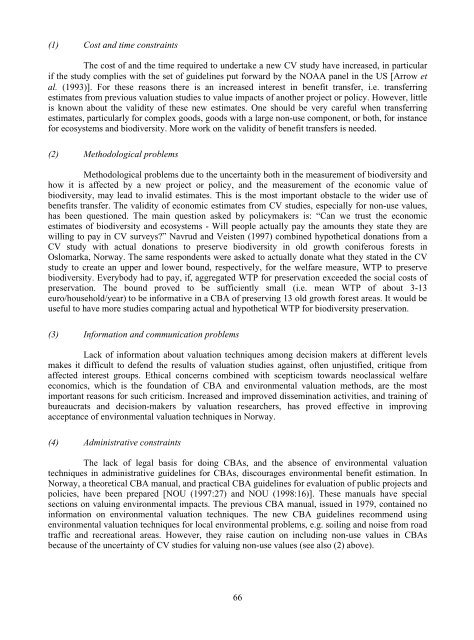Valuation of Biodiversity Benefits (OECD)
Valuation of Biodiversity Benefits (OECD)
Valuation of Biodiversity Benefits (OECD)
- No tags were found...
Create successful ePaper yourself
Turn your PDF publications into a flip-book with our unique Google optimized e-Paper software.
(1) Cost and time constraintsThe cost <strong>of</strong> and the time required to undertake a new CV study have increased, in particularif the study complies with the set <strong>of</strong> guidelines put forward by the NOAA panel in the US [Arrow etal. (1993)]. For these reasons there is an increased interest in benefit transfer, i.e. transferringestimates from previous valuation studies to value impacts <strong>of</strong> another project or policy. However, littleis known about the validity <strong>of</strong> these new estimates. One should be very careful when transferringestimates, particularly for complex goods, goods with a large non-use component, or both, for instancefor ecosystems and biodiversity. More work on the validity <strong>of</strong> benefit transfers is needed.(2) Methodological problemsMethodological problems due to the uncertainty both in the measurement <strong>of</strong> biodiversity andhow it is affected by a new project or policy, and the measurement <strong>of</strong> the economic value <strong>of</strong>biodiversity, may lead to invalid estimates. This is the most important obstacle to the wider use <strong>of</strong>benefits transfer. The validity <strong>of</strong> economic estimates from CV studies, especially for non-use values,has been questioned. The main question asked by policymakers is: “Can we trust the economicestimates <strong>of</strong> biodiversity and ecosystems - Will people actually pay the amounts they state they arewilling to pay in CV surveys?” Navrud and Veisten (1997) combined hypothetical donations from aCV study with actual donations to preserve biodiversity in old growth coniferous forests inOslomarka, Norway. The same respondents were asked to actually donate what they stated in the CVstudy to create an upper and lower bound, respectively, for the welfare measure, WTP to preservebiodiversity. Everybody had to pay, if, aggregated WTP for preservation exceeded the social costs <strong>of</strong>preservation. The bound proved to be sufficiently small (i.e. mean WTP <strong>of</strong> about 3-13euro/household/year) to be informative in a CBA <strong>of</strong> preserving 13 old growth forest areas. It would beuseful to have more studies comparing actual and hypothetical WTP for biodiversity preservation.(3) Information and communication problemsLack <strong>of</strong> information about valuation techniques among decision makers at different levelsmakes it difficult to defend the results <strong>of</strong> valuation studies against, <strong>of</strong>ten unjustified, critique fromaffected interest groups. Ethical concerns combined with scepticism towards neoclassical welfareeconomics, which is the foundation <strong>of</strong> CBA and environmental valuation methods, are the mostimportant reasons for such criticism. Increased and improved dissemination activities, and training <strong>of</strong>bureaucrats and decision-makers by valuation researchers, has proved effective in improvingacceptance <strong>of</strong> environmental valuation techniques in Norway.(4) Administrative constraintsThe lack <strong>of</strong> legal basis for doing CBAs, and the absence <strong>of</strong> environmental valuationtechniques in administrative guidelines for CBAs, discourages environmental benefit estimation. InNorway, a theoretical CBA manual, and practical CBA guidelines for evaluation <strong>of</strong> public projects andpolicies, have been prepared [NOU (1997:27) and NOU (1998:16)]. These manuals have specialsections on valuing environmental impacts. The previous CBA manual, issued in 1979, contained noinformation on environmental valuation techniques. The new CBA guidelines recommend usingenvironmental valuation techniques for local environmental problems, e.g. soiling and noise from roadtraffic and recreational areas. However, they raise caution on including non-use values in CBAsbecause <strong>of</strong> the uncertainty <strong>of</strong> CV studies for valuing non-use values (see also (2) above).66












